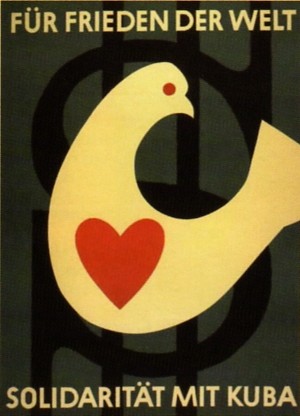Is that the highly desirable model made of up-market cardboard? 
http://www.youtube.com/watch?v=WclNIbnyfRI
The East German National Anthem, for the Zucker & Abrams writing team (Airplane!) film “Top Secret!” (1984) starring Val Kilmer as a young Elvis like performer that gets in trouble in East Germany…

Rich capitalists (or socialists) like U2 can afford as many as they wanted!
I remember that movie. Val Kilmer played a rock&roll singer named Nick Rivers. There was a scene in the movie
where some of his East German fans were holding up signs, one of which read “We Love You Neek”. 
Funny movie 
Exactly, nicknamed “race-cardboard” or “thermoset bomber”.
BTW, you wouldn’t want these guys chasing you:

Looks suspectively familiar:)
Where did you see DDR police with PPSh?Haw many years back was it?
“For world peace. Solidarity with Cuba.”
Yea…Kastro, cuba , revolution…forever:)
Still a style icon: Trabant P601. a common joke back then: “Why 601? 600 people ordered one, only one got it…” Consequences of a state-directed economy.
This was a Miracle of German high-tech industry.
The 600 kg two-stroke easy-parking car was launch that same year when the soviet Sputnik fly over the America for the first time, calling the panic:)
It was a perfect car that prodused for the 30 year modernizing slightly ( Why does have to modernize a Masterpiece?)
It was such maneuvreable car that West German Mersedess just s…ck 
http://en.wikipedia.org/wiki/Moose_test
Moose test
In 1997 the journalist Robert Collin from the motor magazine Teknikens Värld overturned the new Mercedes-Benz A-Class in the moose test, while a Trabant — a much older, and widely mocked car from the former German Democratic Republic — managed it perfectly
I always knew the Western Germans might do noting except luxury.
“Hands off of Vietnam. Solidarity right now.”, 1975
Oh nostalgia…
It was plastic not cardboard:)
BTW very bold technical decision for 1957…
Many Trabant still work and in good condition :), becouse the corrosion not much harmed to its chassis .
look under hood
http://upload.wikimedia.org/wikipedia/commons/thumb/6/61/Trabant_Engine_Block.jpg/800px-Trabant_Engine_Block.jpg
Nothing is superfluous:)
Even fuel-tank here:)
Must have been before 1961. In September of 1961 the border police of the GDR was officially re-named into “Grenztruppen der DDR” (border troops of the GDR).
This was a Miracle of German high-tech industry.
The 600 kg two-stroke easy-parking car was launch that same year when the soviet Sputnik fly over the America for the first time, calling the panic:)
It was a perfect car that prodused for the 30 year modernizing slightly ( Why does have to modernize a Masterpiece?)
It was such maneuvreable car that West German Mersedess just s…ck
I drove both, each has its special virtues.
I remember being visited by a part of our family from the GDR right after the borders were opened. We drove in their Trabant through my (crowded) hometown. I will never forget the glances on peoples eyes.:mrgreen:
I always knew the Western Germans might do noting except luxury.
Absolutely, but we didn’t take a 40-years-break like our eastern brothers and sisters.;)…but we are living in a time of changes once again, fuel -as an example- is luxury now.
That’s why soon your peoples of your hometown would look at Plastic 0,6 litres Trabant with …envy;)
You might drive whole a week by one filling up, while they have to stay their 2-3-4 litres Mersedess/BMV at home and go to work by bicycle:)
There is always the opportunity:
http://cgi.ebay.de/Trabant-P601-Kombi_W0QQitemZ230303635527QQcmdZViewItem?hash=item230303635527&_trkparms=72%3A1279|39%3A1|66%3A2|65%3A12|240%3A1318&_trksid=p3286.c0.m14
There may be nothing superfluous in there, but there appears to be something rather important missing. Namely an engine!
It should be a great advantage indeed 
During age when fuel will cost so much to turn back to the Horse-drawn 
BTW did you see the New Trabi

It will cost 50 000 Euros  Just like an Mersedess of C-class.
Just like an Mersedess of C-class.
It was quite amazing interesting post dear Librarian. Thank you. I 've learned some things about DDR just now.
Oh, thank you very much, my dear Mr. Chevan. You know, I always liked those tranquil, contemplative moments in a foreign country. 
And that Communist-Church DUALISM always wonder me… You know , it seem for me the Communism ideology ,in sense, was a …Other form of Religion.
That certainly is a collosal philosophical theme, my dear Mr. Chevan. However, I think that it really is much more complex then usually supposed.
Whether we try to find a common element which is present in all societies of the world, or whether we seek to track down this element, in the end we will note that there is always in it an ingredient which is the reverse of rational. Reliance, or faith, emanates from the observed fact that man is both a finite being who is not wholly master of his fate and a rational being who obstinately refuses to be reconciled to the disturbing fact that - so far as his body is concerned - he comes to be and passes away and is never heard of again. 
This is no place to go into the complicated question of how man has sought to prolong his existence, to identify it with a larger and more permanent whole, or to “get in” on the right side of the puzzling powers that rule the universe and thwart him at every turn if he does not know the secret of how to appease them, to approach them and to please them. Nevertheless, some discussion of these elements is necessary if we are to understand the curious phenomena of the tragically blank “secular” belief of today.
You see, the XX century inherited from the nineteenth an affecting faith in the ability of physical science to explain all things and to deliver man from the bondage to his environment. It was reared on the Creed of Progress which had been appropriately deduced from the immense expansion of scientific knowledge and the practical and constructive use to which that knowledge had been put. Early twentieth-century man was all too ready to equate the undoubted extension of man’s control over matter with a corresponding improvement in his spiritual and moral estate. He could point to the abolition of the slave trade and of slavery, to an increased social consciousness, and to the development of democratic systems of government which were seen as the practical expression of the doctrine of the equality of man - a doctrine recognized by both Christians and their opponents, the modern communist heirs of the French Revolution. Faith in God therefore had been largely superseded by faith in the perfectibility of the human species by its own unaided efforts. The nightmare of original sin was driven deep down into the unconscious, and man saw himself as the sole master of his destiny. “Work out your own salvation with diligence”, was the ruling credo of the times and also one of the sayings of the Buddha, and this is what our optimistic socialist forebears sought to do. Here, however, the parallel breaks down; for nineteenth-century optimism, secure in its faith in progress, looked forward to an age when science would have perfected all things. The Buddha was less naive: for though he preached that each individual must work out his own salvation alone, he had no illusions at all about the perfectibility of this world. How, indeed, could this world, unstable, impermanent, and in perpetual flux, this impure amalgam of dissatisfaction and pain, possibly be perfected? There could be no salvation in or for this world: that lay elsewhere.
Nineteenth-century rationalistic, scientifically based optimism – the very intellectual platform of communism – then, was comparable to Buddhism in the emphasis it laid on individual effort in the battle for individual salvation, but it differed from it profoundly in that it placed all its hopes on this world. Faith, then, it had: but faith in eternal life it had not. It offered rather a substitute for this angelic state - the perfectibility of the human species on this Earth. In its way this was a noble and altruistic ideal; for the partisans of progress - in theory at least! - ceased to worry about personal immortality and projected themselves into future generations of a perfected humanity.
These values, however, were rudely shaken by world wars, and by subsequently harshly undertaken popularization of the aqusitive culture based upon selfishness and greed. The WW2 demonstrated, among other things, that science, although she had the capacity to perfect the material lot of Man on Earth, had also the power utterly to destroy him. After the nuclear bomb perhaps for the first time in history the parable of the Third chapter of Genesis seemed to make obscure sense. The Tree of Knowledge proved a dangerous thing to play with if, at the same time, man preferred to ignore the existence of the Tree of Life. Material progress was shown, in bitter practice, to be in no sense a corollary to moral progress: it had been an absurd superstition to suppose that this could be so. One of the lessons that the World War taught us was that revolution, both industrial and political, had cut us off from our past. We had lost our old faith, my dear Mr. Chevan, and the substitute faith had proved as an impractical delusion. Furthermore, we were subsequntly told that every faith, or every reliance is completely irrelevant to the immediate concerns of daily life. The Gadarene swine won the battle, and defeted our metaphysical reliance. Consequently, we had ceased to be reliant any more. 
Moreover, it is here that the great dark shadow of universal doubt has fallen darkly on what once was so radiantly bright, my dear Mr. Chevan. Because in these days there is an omnipresent fear - both here at my home and abroad - that we are thickening and hardening into a mold that denies the deeper and nobler promise of the New World. We are distracted, diverted, bewildered today. But the tragic folly now would be to surrender the opportunity because the door has been so little used.

Universe and present-day Humanity
Man alone, my dear Mr. Chevan, is capable of asking what he will do with his life, with the little span of time allotted to him. And likewise he can help to shape the society of which he is a part - for good or for ill. It is in this choice that sets man apart and enables him in the face of an infinite universe to call his soul his own. To believe that he will reject this choice is to admit to utter despair. To resist the mood of pessimism in a time such as ours is not easy. Yet, there are many today who refuse to surrender to the conformity of fear and doubt, to a gloom that is as unreasoning as the facile optimism of a short time ago. They are rediscovering the inheritance so long taken for granted, the foundation so overgrown and obscured. And no, this is no retreat into the comforting enclosure of the past. Rather it is an effort to confront man’s loneliness, his fragmentation, his islolation from what has gone before. One may say, with due caution, that this is a first step, this rediscovery of the basically perilous place in which we find ourselves and of the confused and careless way by which we got there. In a sence – that is the beginning of a new hope.
Oh, Lord – yet again an utterly boring philosophical inquiry into the nature of human values in the modern world… Mea culpa, mea maxima culpa!
Therefore, back to the reminiscences about the DDR! 
DDR - Part II
While DDR housewives may queued for vegetables, nothing was spared on the behalf of the development of the young. The young were hope of the socialist future!
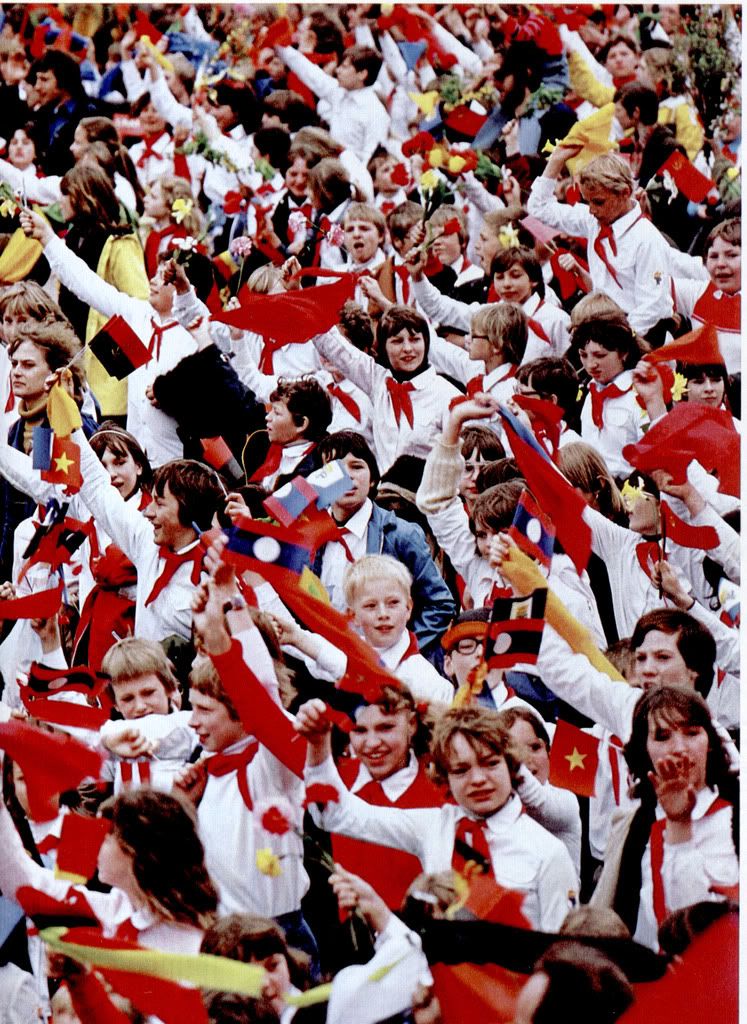
May Day – Young DDR Pioneers
In the district of Köpenick, a million and a half children a year enjoyed in a colossal Pioneer Palace, a complex of sports and hobby facilities (Olympic-size swimming pool, gymnasium, ballet studio, rooms for chemistry, pottery, puppetry, model-airplane building, folk-singing, etc.). One room simulated space flight, with videotaped scenes of earth during blast-off. All free.
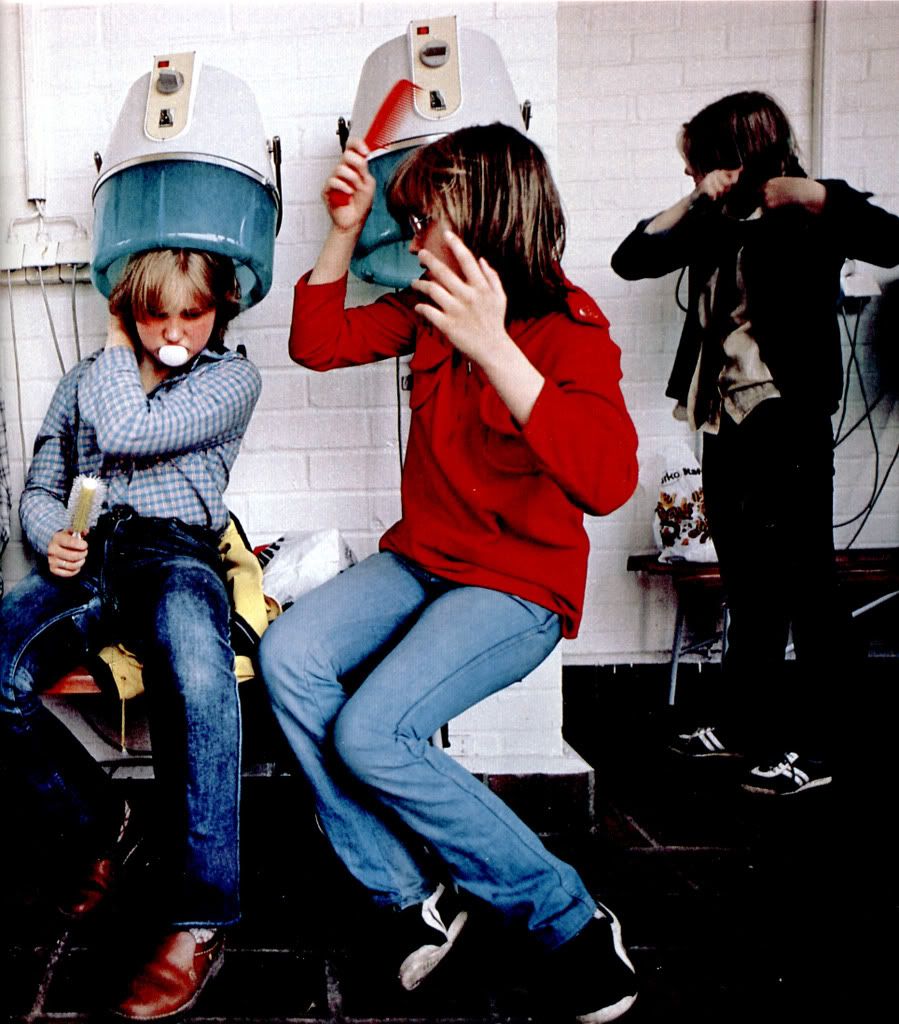
Pioneer Palace – after a swim in the Palace pool young pioneers dry their hair (bubble-gum was available as well!)
Although the state heatedly separated itself from the Nazi past, old Prussian military traditions had not lost a stride in the DDR! On the contrary, it seemed that the omnipresent remnants of the Prussian Socialism were deeply embedded in the society. Prussian roots and their positive societal collocations were acknowledged by a cautious but increasingly confident state. And the word “German” was used without a bitter taste of the discreditable past. Most simbolycally, the equestrian statue of Frederick the Great, banished to Potsdam for 30 years, has been remounted on its pedestal on Unter den Linden. All day people just looked at the old “Comrade Fritz”. Moreover, I also have to admit that after watching the presented military excellence and perfectionism of the Wachregiment der Stadtkommandantur Berlin it seemed to me that even Der Alte Fritz’s face looked somehow different… someway more satisfied, with a gentle smile upon his bronze lips. Apparently, I was not the only one who was impressed…

Professional colleagues from the other side of the hill were also impressed by the NVA - Stechschritt
In 1945 more than half of all Germany was physically destroyed. And whereas the West was quickly restored with Marshall Plan money, East was further ravaged by a badly tormented and initially resentful Soviet Union, who additionally was not widely admired. Industries and resources were stripped, reconstruction seemed hoples - that was base zero when the time began for the new social order. However, with a few raw materials but brown coal, German mind, laborious hands, shared aims and amicable internationalist alliance, the DDR has become the world’s tenth most productive industrial nation and the second economy of the world capable to achieve 5.5 % net-growth in a period of general recession in 1973. Products varied from model trains at VEB Berliner TT-Bahnen to thyristor-driven locomotives at VEB Lokomotivbau Elektrotechnische Werke “Hans Beimler” in Henningsdorf, but they were accepted and esteemed in 144 diferrent states, both socialist and capitalist.

VEB Karl Zeiss, Jena – synonym for quality and technical finesse
Leipzig, another of Germany’s medieval trade centers, shared with Dresden and Berlin the commercial leadership of the state. Dresden, a commercial city flanking the broad Elbe, showed that commerce and art may be combined. Chemnitz, noted for its textiles, contributed much to the fame of Saxony. In Leipzig people were busily engaged in all kinds of printing and in directing the world’s outstanding Sample Fairs, where numerous products from countries all over the world competed peacefully with each other. Thousends of buyers, representing nearly every country where industrial equipment is used arrived there. Almost every variety of article of merchandise was displayed by manufacturers from far and near. Buyers in some years numbered as many as 180,000.
These fairs offered an excellent opportunity for a visitor, whoever he was, a buyer or not, to become acquainted in a short time with the kinds of commodities in which many countries trade. Rich and poor, farmers and bankers, all attended the fairs. There one was able to observe numerous nationalities among the sellers, buyers and spectators.

Leipziger Messe – lively place of international trade
Most East Germans used their weekends for the pursuit of leisure – the serious, methodical pursuit of people actually learning how to relax again. The parks and numerous sports facilities were filled with earnest legions of runners, swimmers, bicyclists and riders.
One of the most interesting places in the Dresden area was the Moritzburg. This beautiful Baroque palace, surrounded partly by water, was previously used chiefly as a hunting lodge, since it was located in the midst of woods through which many streams flow. The annual stallion parade was a more recent tradition, but those lazy days on the banks, amongst pines and oaks and shy East German campers were indeed wonderful. In the evening each family erected a little canvas fence around its campsite, and portable TV sets flickered with soccer games.
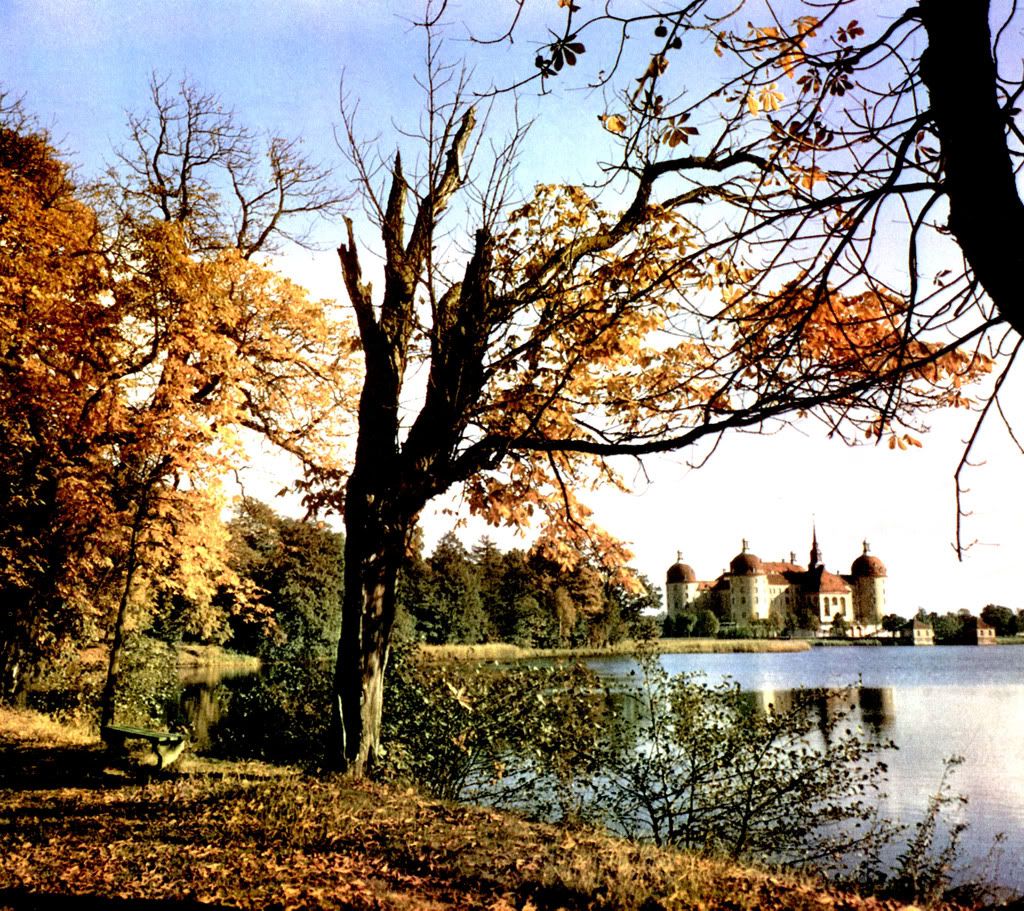
Moritzburg – wonderful place for rest and contemplation
There borders and world politics seemed distant, the life affluent with coffee at outdoor tables, and even the voice of the most gentle Princess who ruled and forever will live in our hearts, Audrey Hepburn, was there with the immoertal Moon River… unce upon a time in one of the least provincial parts of the world.
To be continued… with some generally unknown but highly intriguing details about that unfortunate and brutally ridiculed little vehicle.
DDR/GDR “Days of Honour”:
- “Day of the Labourers of Mail and Telecommunications” - every second sunday in February
- “Day of the Civil Defence” - February 11th
- “Day of the Employees of Trading” - every thirs sunday in February
- “Day of the NVA (National People’s Army)” - March 1st
- “International Women’s Day” - March 8th
- “Day of the Metal Worker” - second sunday in April
- “International Day of Action and Holiday of the Labourers” - May 1st
- “Day of Liberation from Hitler-Fascism” - May 8th
- “Day of the Youth Brigades” - in May or June
- “International Day of the Infant” - June 1st
- “Day of the Employees of Railway- and Traffic-System” - first or second Sunday in June
- “Day of the Teacher” - June 12th
- “Day of the Collective-Farmers and Workers of the socialist Forestry and Agriculture” - second or third Sunday in June
- “Day of the Labourers of Water Management” - second or third Sunday in June
- “Day of the Construction Worker” - third or fourth Sunday in June
- “Day of German People’s Police (Volkspolizei)” - June 1st
- “Day of the Miner and Energy-Labourer” - first Sunday in July
- “World Peace Day” - September 1st
- “Day of the Employees of Housekeeping Service and Municipal Economy” - third Saturday in September
- “Day of the Republic (GDR’s national holiday)” - October 7th
- “Day of Maritime Traffic Economy” - October 13th
- “Day of the Employees of Light Industry and Food Industry” - third Saturday in October
- “Victory of the Grand Socialistic October’s Revolution” - November 7th
- “World Youth Day” - November 10th
- “Day of the Chemical Labourer” - second Sunday in November
- “International Student’s Day” - November 17th
- “Day of the Metallurgist” - third Sunday in November
- “Day of the Border Troops of the GDR” - December 1st
- “Day of Public Health Service” - December 11th
- “Pioneers Anniversary” - December 13th
Of couse these weren’t all “days-off”. Only on the following days there was no work duty: International Day of Action and Holiday of the Labourers, Day of the Republic, New Years Day, Christmas, Good Friday and Easter Monday.
We can also add that reasons included it was communists’ measure to reduce the flow of emmigrees from the east to the west.
Soviets and East Germans wanted to rebuild East Germany, to improve East German living and economic conditions, and it helped East German, in various senses, pay war reparations to the Soviets.
Losing people didn’t help from some perspectives.
It also looked bad for the Soviet Union and communism as a political/social/economic system and way of life, to have so many people “vote” with ther feet to leave for good.
I’m sure we could add more reasons why they built the Berlin Wall, against that non-communist exclave island of “West Berlin” that was deep within East Germany.
These factors and other were still evident in the early to mid-1980’s, while I travelled by train along several allowed rail travel corridors through East Germany, to and from West Germany and West Berlin. Still evident dispite obvious effort to dress the windows and give false image of conditions in East Germany. Sehr Schön, lieder falsch.
I’m sure we could add more reasons why they built the Berlin Wall, against that non-communist exclave island of “West Berlin” that was deep within East Germany.
Indeed, we could my dear Mr. Restitutus. The “antifascist protective barrier”, as the East Germany called the Wall, was erected by the GDR in august of 1961, to stem a mass emigration to the West - loss of three million people that threatened the foundation of the new state. But the main reason for the nascendence of the Wall was the fact that the World War II has never actually ended, especially there in Berlin, because the final result of the WW 2 was a victory without peace. However, at the very end, the main direct cause for the nascendence of the Wall was the unprecendented success of pretty unknown operations Mighty Wurlitzer and Splinter Factor.
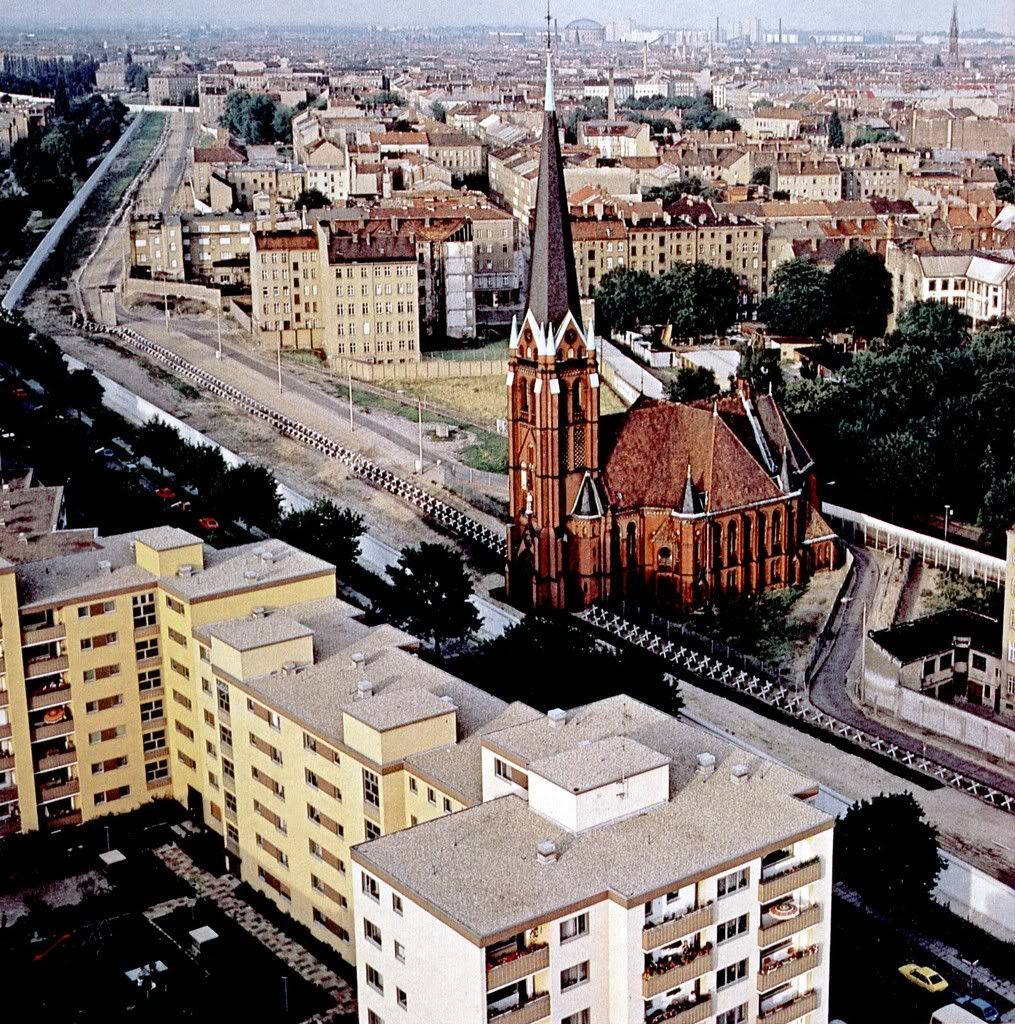
The Wall – Bernauer Strasse
As you know, between 1945 and 1961 Berlin was the hot point of the Cold War – highly specific state of international affairs, born out of the division of Europe and based upon the irrational fear that the Communist bloc will launch another full-scale war. But the grim nature of the balance of terror that aggravated the somberness of the political outlook was the fact that the division of the world actually was a fundamental economic division, desperately despised by the prominent members of the yesterday-world. The main problem actually was the grim goal of a re-creation of the “liberal world economy”, i.e. a world economy dominated indirectly through “free” markets in goods and capital, more precisely by a few powerful countries which failed in Great Depression. The post WW2 Master Plan to turn the clock back to 1914, however, had broken down, because the world was not the same any more. An attempt to implement this previously mentioned general plan actually endangered the very existence of the modern Europe.
The solution of this difficulty was due to a new element in the international political situation. This new element was the growing antagonism of the two Giant States which were left dominant - each in its own sphere - after the conflict which shaterred the strength of Europe. The Potsdam Agreement of the summer of 1945 represented the last flicker of mutual understanding. The Americans resented the attacks of the Communist parties on U.N.R.R.A. and the simultaneous steady increase of their share in its total burden (in the end 77 %), and were exasperated by the deterioration in political position in Eastern Europe. They were far from realizing that even this proportion did not quite adequately express their relative ability to bear economic sacrifice. Whether or not the political or economic exasperation was the main cause of the demise of U.N.R.R.A. is difficult to decide. But wound-up it was in Europe in 1947, and soon afterwards in Asia too.
The Moscow Conference, which tried to arrive at some definite agreement on Germany, broke down, and American hostility to the Soviets became open. The American origin of the Morgenthau plan for destroying Germany as an industrial state was forgotten – a plan the partial implementation of which had prevented a speedy restoration of the vanquished and a utilization of her resources and skill to repair the damage she had inflicted on Europe. The erstwhile enemy rapidly advanced into the position of a prized potential ally.
When it became clear that Europe was drifting into a crisis, the invitation of the Soviet Union to participate in the Paris Conference on European Economic Reconstruction was hardly conducive to making the US Congress, dominated, as it was, by hard-liner Republicans, amenable to granting a generous unilateral contribution to the world. The brusque withdrawal of Molotov opened the doors to help for Western Europe. The acceptance by the US Congress of the European Recovery Programme initiated by General Marshall represented a fundamental departure in economic relations between sovereign countries in peace time. It was similar to war-time arrangements such as the English subsidies in the XIX century, or Land Lease and U.N.R.R.A. Immediate need rather than ability to repay, or the possibility of profitable investment was made the criterion of economic relations between the dominant and the peripheral countries.
The short-term success of the new approach was striking: production in Europe expanded in the following 18 months by over a fifth. By 1950 it had expanded to 21 % above pre-war levels. Agricultural output, which had been lagging behind, also recovered. Equally impressive was the performance in the international field. The visible adverse balance of the Western European countries with the rest of the world fell from some $ 6 billion in 1947 to $ 4,2 billion in the second half of 1948. This achievement was the more remarkable in that consumption standards improved substantially and investment expanded simultaneously.
The long term plans of the Western European countries initiated by the US were to have stabilized and extended this recovery. The weakness of the approach was that it did not offer any incentive to individual member countries for increasing investment and holding back consumption. Indeed, the morer a country tried to rely on its own efforts the grater was the danger that its share in the total aid would be cut. Nor did the Europeans try, or the Americans insist on, an effective coordination of European investment plans. And thus a unique opportunity was lost of increasing productivity and competitiveness. Finaly, far from having regard to the relative wealth of the countries aided, the immediate political end of the plans plainly manifested itself: in order to to still immediate discontent the existing maldistribution of wealth in Europe was accepted. The richer areas received most of the money! And that was only a pale start…
Developments in the Soviet orbit, though not free from sharp set-backs in some fields, especially agriculture, have given further proof of continued and ferocious energy in expanding supra-national productive capacity. All indicators suggested that the economic achievements of the ill-fated Soviets, previously completely neglected by western military and economic strategists, will pose awkward problems for the West. A correct appraisal in the West, and especially in the US, of the Soviet economic system and its potentialities has noty been easy. All of free world traditions revolted against acknowledging its tremendous dynamism. After corrections for overstatements, all evidence indicated that national output in the Soviet Union, which could hardly have been more than two-thirds of pre-war in 1946, by 1950 exceeded pre-war levels! Since then progress has slowed down, but it seemed probable that the increase in total Soviet output is of the order of magnitude of at least 6 to 7% compound per annum. The other problem was that mathematicians at RAND calculated that it might well be higher, possibly as high as 9 %! The rate of growth of manufacturing production alone seemed to have been substantially higher, possibly as high as 11%! In other words, my dear Mr. Restitutus, Soviet production doubled every twelve years or so. This was compared with an increase of American manufacturing capacity of roughly 5 to 6 % compound per annum between 1946 and 1953, and with a British increase of about the same order of magnitude until 1950 and again in 1953-54. Overall production in the West in the West increased much less – between 3 and 4 %. That predestined that coursed Soviet Union will be able, in a decade or so, to obtain a substantial absolute preponderance over Western Europe unless energetic action is taken by the West. Success in the economic field could surely not accrue to a system so… cruel, unnatural! No way - it must be reserved for Free Private Enterprise! Therefore all the necessary actions were undertaken…

Official US estimation regarding the Soviet bloc GDP growth
Forced brake of the post due to well known techical reasons. :roll: To be continued…
Part II
As beautifully described in a book The Declassified Eisenhower by Blanche Cook, “since nuclear Armageddon was unacceptable, the US administration pursued alternative means to ensure America’s dominance in the race against the Soviet Union and in the race to secure access to the world’s resources and markets. That was, basically, a commitment to a laissez faire, classicistic liberal economy. Others called it Empire philosophy. Whatever it is called, to control the world’s resources and defend them against nationalists and communists proved to be an ongoing and draining experience.”
Throughout the decade following the war, the CIA was highly active and utterly succesful in forming the flames of discontent in whole Eastern Europe, besides – in magnificently many ways. Radio Free Europe, broadcasting from West Germany, never missed a dirty trick.
In January of 1952, for example, after CIA learned that Czechoslowakia was planning to devalue its currency, it constantly vexed the population, thus stimulating a nation wide buying panic. RFE commentaries, previously proffesionally prearranged by distinguished Madison Avenue proffesionals and agencies hired by CIA, like Ted Bates & Co. (later held guilty by the Federal Trade Commision due to deceptive advertising when they used a plexiglass mock-up of a sheet of sandpaper in a TV commercial which claimed that a Colgate-Palmolive shaving cream could shave sandpaper!), J. Walter Thompson, Interpublic Inc, Young and Rubicam, etc.
Western Cold Warriaors instituted also a crude campaign of sabotage and subversion against East Germany designed to throw the economic and administrative machinery out of gear. The CIA and other US intelligence services in West Germany, with occasional help from the likes of British intelligence and the West German police, recruited, equipped, trained and financed different activist groups and individuals of West and East. Finding crusade was not difficult, for in post-war Germany anti-communism lived on as the only respective vestige of Nazism.
The most active of these groups, which went by the name of Fighting Group Against Inhumanity, admitted that it had received financial support from the Ford Foundation and the West Berlin government. Subsequently, an East Berlin newsmagazine published a copy of a letter from the Ford Foundation confirming a grant of $ 150,000 to the National Comitee for a Free Europe so that it, in turn, could support the humanitarian activities of The Fighting Group Against Inhumanity. The National Comitee for a Free Europe, in turn, was a CIA front organization which also ran Radio Free Europe.
Of course, all this awkward activities turned into public affair and a worldwide scandal only later, more precisely in 1963, when a former US diplomat Irvin Scarbeck was convicted of delivering US governmental secrets to a Polish agent.
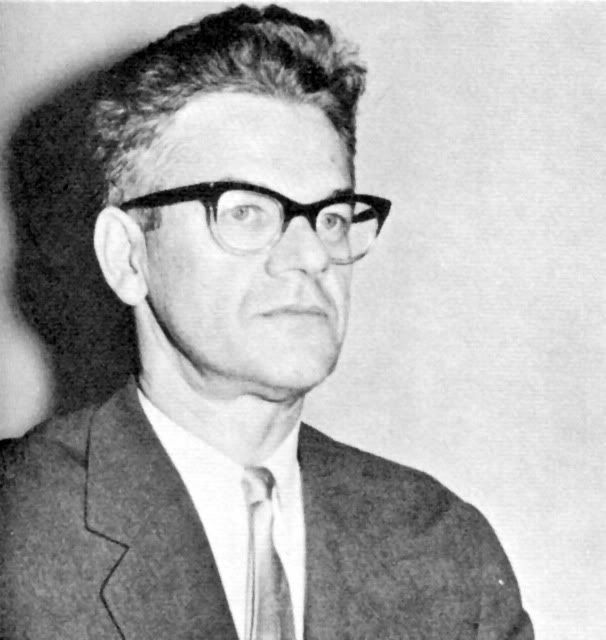
Irvin Scarbeck – US diplomat who uncovered secret Western operations in DDR
In a completely traditionalist, absolutely standardized “Honeypot” operation, perforemed by brave and talented agents of the Polish secret service (Służba Bezpieczeństwa Ministerstwa Spraw Wewnętrznych), Polish agent Ursula Maria Discher was prepared to act as Mr. Scarbeck’s mistress, and after that he was succesfully persuaded to protect her from an imaginary public disclosure by feeding different US governmental secrets to Polish agents who had photographed them in flagrante delicto.
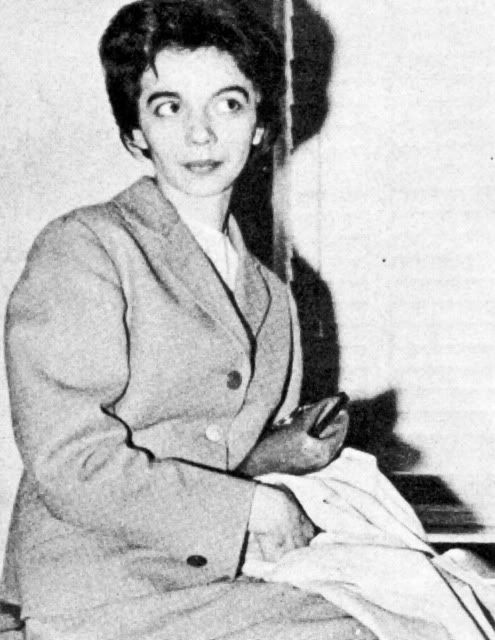
Ursula Discher – brave Polish secret agent
Obtained informations also discovered that different formaly non-governmental, but actually clandestine organizations purchased escapes of East German citizens and charged from $ 14,000 to $ 60,000 per body. The US student Robert Mann got 21-month jail term in East Berlin when he was exposed as a secret agent who served as a main fleeing organizer in East Berlin.
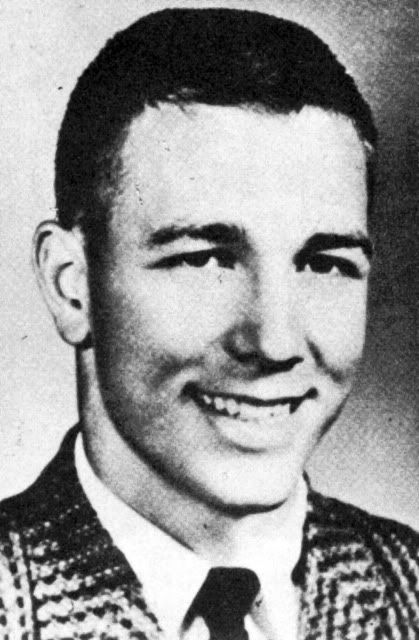
US Student Robert Mann
Tightened security measures were introduced when the German unity no longer seemed plausible, and succesfully inhibited further activities. Strangely enough, this tenuous stability was highly dependable upon the Wall, which has restored order to the chaos of daily confrontations.
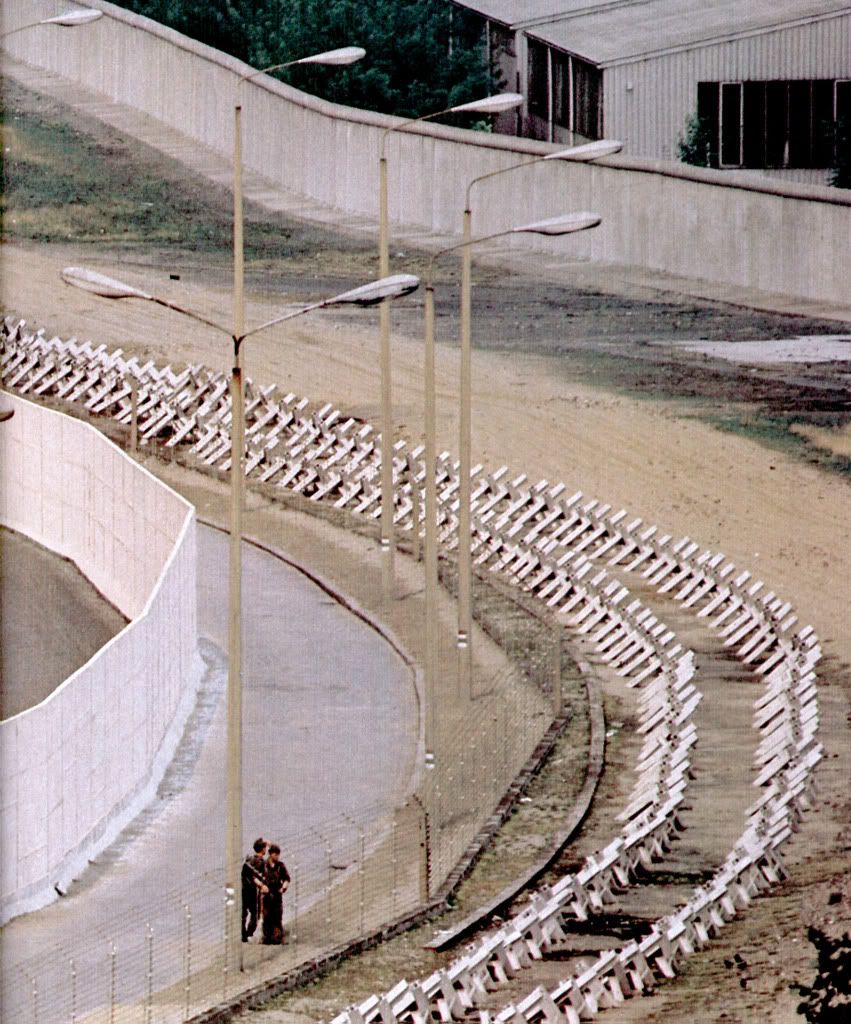
Berlin Wall - the antifascist protective barrier of the GDR
Ironically, Berlin began divided, as two small XIII century traiding settlements – Berlin and Kölln – on the opposite banks of the river Spree. Neither town was disposed to unity, even after town fathers forged a political allience around 1300. The armed forces of the United States, Great Brittain, and France, always called “protective” rather than “occupation” powers - unlike the Soviet Union - still maintained a presence in the city according to wartime and postwar agreements, entrenched in their respective sectors.
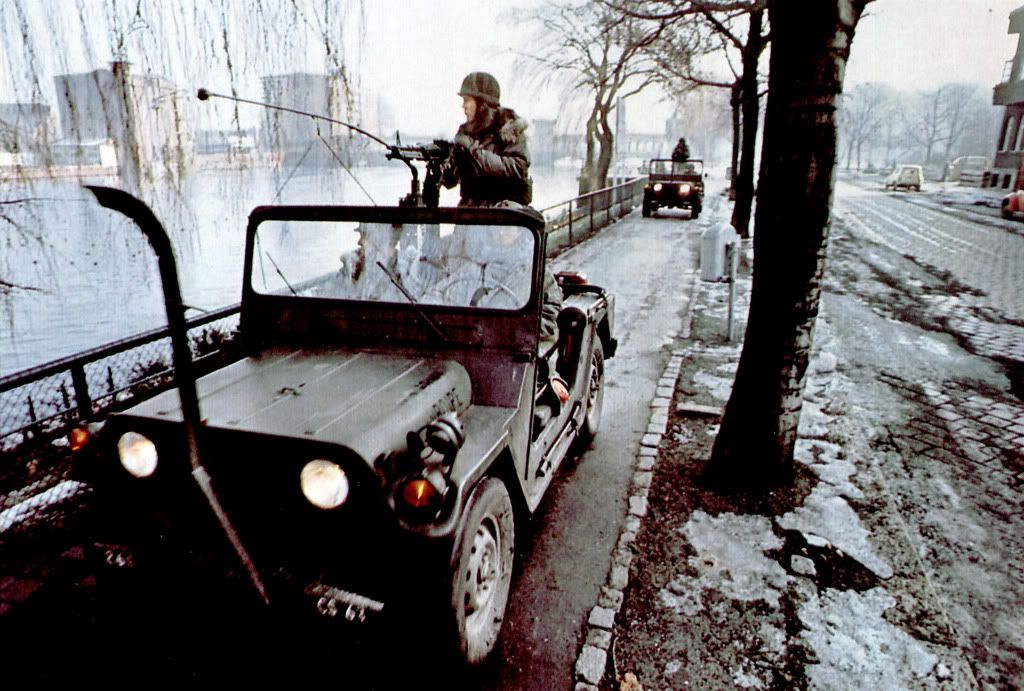
The US Army patrol in Berlin-Kreuzberg
Showing allied muscels alongside the Wall, notably less-photographed US units also patroled the edges of West Berlin. If West Berlin was to be attacked, there would be an anctive defense, as stated by former Maj. Gen. Calvert P. Benedict, commandant of the US forces in Berlin. However, all has been quiet on the front. The 12,000 troops of the Western allies seemed almost symbolic, like the Swiss Guards at the Vatican, because the city of west Berlin was encircled by half a million soldiers of the Warsaw Pact – 350,000 Russians and 150,000 East Germans.
Fortunately, when the Quadripartite agreement arrived in 1971, the West finally acknowledged the East German state, paving the way for both Germanys’ entry into the United nations in 1973. Since then Berlin has remained surprisingly stable in a world atmosphere crackling with freshly introduced Détente.

US confirmation - as life in the GDR improved, escapes desiccated
But that prosperous and now so utterly remote epoch was part of a completely different story… promoted this time by a new political tune Unser Opa, unser Opa, ist der beste von Europa - boldly played by both SPD and SED.
Of course, the intellectual heredity in the rear of the tune was well known. And honestly - highly amiable. 
http://boomp3.com/listen/elux8hb_p/wir-sind-des-geyers-schwarze-haufen
To be continued…
Dear Librarian: Thank you very much for excellent overview of western Cold War non-military activities.  As a frequent researcher/library patron and former librarian, my hat is off to you!
As a frequent researcher/library patron and former librarian, my hat is off to you!
Eastern Cold War non-military activities are also quite numerous and intriguing, as we have been getting more information after the Berlin Wall and other barriers came down.
Of course, all information is requires careful scrutiny. 
Related to both east & west, one of my favorite Cold War period movies is “One, Two, Three” (1961), starring James Cagney.
Thanks again. Best regards, +r
My dear Mr. Restitutus – what can I say? Thank you very much for those truly kind words! As a professional librarian I was repeatedly faced with the problem which is generally know as compressibility of information, and - as you know - this problem never was an easy one to solve. Even in the dawn of the modern world, when Saint Isidore of Seville tried to compress into a single work the extent of factual knowledge available to his contemporaries, it was already impossible to compress all the important facts. And by now one of the chief difficulties which beset the researcher in any field is that he has to spend most of his already sadly limited time checking what is available before he can even hope to make any original contribution to his subject. 
Yes, my dear Mr. Restitutus, without any doubt any attempt to evaluate the true-life situation of those days must necessarily lack the documented facts. Nevertheless, I somehow do feel that the present-day historian ought at least to edge his way modestly in where bolder spirits run freely. 
However, it has to be emphasized that those times were truly extraordinary ones, truly bold and optimistic, fulfilled with enormous perspective of a silky, faultless world, in which – as stated by Madame Dorothy Row
…We’ll just a press a button for food or for drink,
For washing the dishes or cleaning the sink.
We’ll ride in a rocket instead of a car.
And life will be streamlined…
After the war.
But the unbridled joy that swept the world as the WW2 ended was short – lived. To solve the immense problems of economic reconstruction, it was necessary for governments to play a much larger part than ever before in the economic and social life of numerous countries. During the war, governments had controlled the economy to ensure a maximum war effort, and they did that tremendously well. Many argued that if such control was effective in wartime, it should also work in dealing with numerous problems of post-war reconstruction. Moreover, the horrors of war had not blotted out of memory terrible sufferings of the Depression years in thirties. If governments could raise huge sums of money to fight wars, surely they could also finance programmes that would eliminate the evil conditions which bred wars.
Such considerations produced widespread public demand for political, social and economic reforms. But numerous examples of concealed backstage political choreography of already existing, well-established associations and interest groups have demonstrated that there will be hard difficulties in fulfilling in practice the new societal theories. Opposing philosophical models, mutual rivalry and deliberately generated suspicion tended to divide both the freshly established United Nations and the whole world into two hostile camps poised against each other. Irony of the moment was that Soviet Communism and American Capitalism actually represented an sadly distorted development of the strong and vivid, deeply embedded liberalistic passion for intellectual absolutes, with amazingly similar and actually shared high-end, generally know as Heaven on Earth For All.
Oddly, but in those times in certain parts of the planet even the forces of Armageddon were fruitfully engaged in a push for material progress. Tourists, for example, were encouraged to view the nuclear blasts from the middle of the town, or on the rooftops of the hotels. After all, those compulsive gamblers concealed in every single human being were barely able to notice the rumble, not even to mention the afterglow…

Also, I was very pleased to read about your affection toward Cold War era movies, because I do share that affection as well. For me, hovewer, “The Russians Are Coming” (directed by Mr. Norman Jewison) is representing one of the best film comedy features, even though it never was a popular box office film. It was way ahead of its time, and it still is ahead of its time today, being incredibly modern, and deeply humanistic in its narrative approach. Mr. Alan Arkin, if truth is to be said, actually deserved an Oscar, and that line “Emergency! Everybody to get from the street!” still is amongst the most hilarious in any film:
http://www.youtube.com/watch?v=pXXGep9RB34&feature=related
Once agin, my dear Mr. Restitutus – thank you very much for your kind words! I hope that I will be able to do honor to all my liabilities. Time will be the only killing-factor in my humble efforts… 

